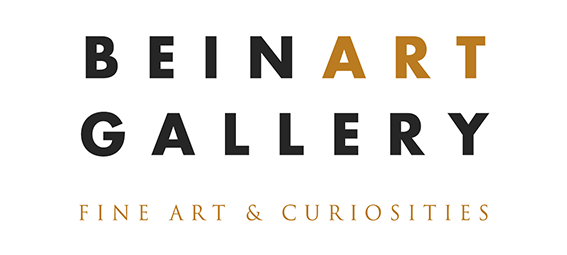
With their striking juxtapositions of time and place and questioning of humanity's influence on our ever changing planet, David Ambarzumjan’s masterfully created, vibrant paintings have garnered a huge amount of attention. Ambarzumjan’s unique nature paintings are becoming somewhat of a phenomenon. At a tender young age when many are yet to find direction, Ambarzumjan has already begun to make his mark on the art world, with a passion and vision admired by many.
The Munich based artist gave us some insight into what inspires him to create in the lead up to his solo show at Beinart Gallery, featuring the newest works in his Brushstrokes in Time series.
These are landscapes I’ve been to, but also landscapes I've imagined myself being in. I wanted to show how diverse life is and how incredible it is that all this originated from nothing but dust in outer space. A brushstroke of life on a blank canvas, so to say.—David Ambarzumjan

This Was Water - Oil on wood panel for David Ambarzumjan's solo show, Brushstrokes in Time, at Beinart Gallery.
Indigo Rawson-Smith: Hi David, I’d like to start out by asking about your artistic background. I know you discovered your affinity with art and started your art study at a very young age. Did you grow up in an artistic family? What was it that drew you to art?
David Ambarzumjan: My first vivid memory of doing art was in preschool. One day we were given canvases and acrylics to play with and I wanted to paint a family of penguins. It was so exciting to create something out of nothing and slowly see the painting come together. When my teacher saw the finished painting, she encouraged my parents to nurture the talent that she saw in me. I created two paintings of the penguins that day. Funnily enough, she kept one for herself.
My parents were always supportive of my interest in art. Especially my father, who is himself artistically talented but sadly never got the encouragement from his parents, let alone the education as a child. When he saw my interest at a very young age, he made sure that I got the education to improve my artistic skills.
 Breach - by David Ambarzumjan for his Brushstrokes in Time series.
Breach - by David Ambarzumjan for his Brushstrokes in Time series.
IRS: What was your learning process and education like? How important was your own exploration and experimentation to getting where you are now?
DA: I think ‘unconventional’ is the best way to describe my education growing up. Once a week after preschool, and later primary school, I attended an art course for children, where I was able to experiment with different mediums from drawing to painting to ceramics. Right after I went to the city museum for another art course that was technically targeted towards older people. But somehow they allowed me to join them in painting still lifes and discussing and reproducing traditional paintings from the museum archive. I was also learning to sculpt for a short time, under the wing of an Armenian artist. Needless to say, I’m grateful to my parents for giving me all these possibilities to explore my artistic interests at such a young age, while also supporting the hobbies of my four brothers, all without any financial security.
While in High School I wasn’t attending art courses anymore, because it was starting to feel like a chore. I felt like I had laid the groundwork enough to continue to learn and experiment on my own terms and in my own time. This was also around the time that I started to share my art online. Seeing all these different artists there, succeeding in their craft, motivated me even more to do the same.
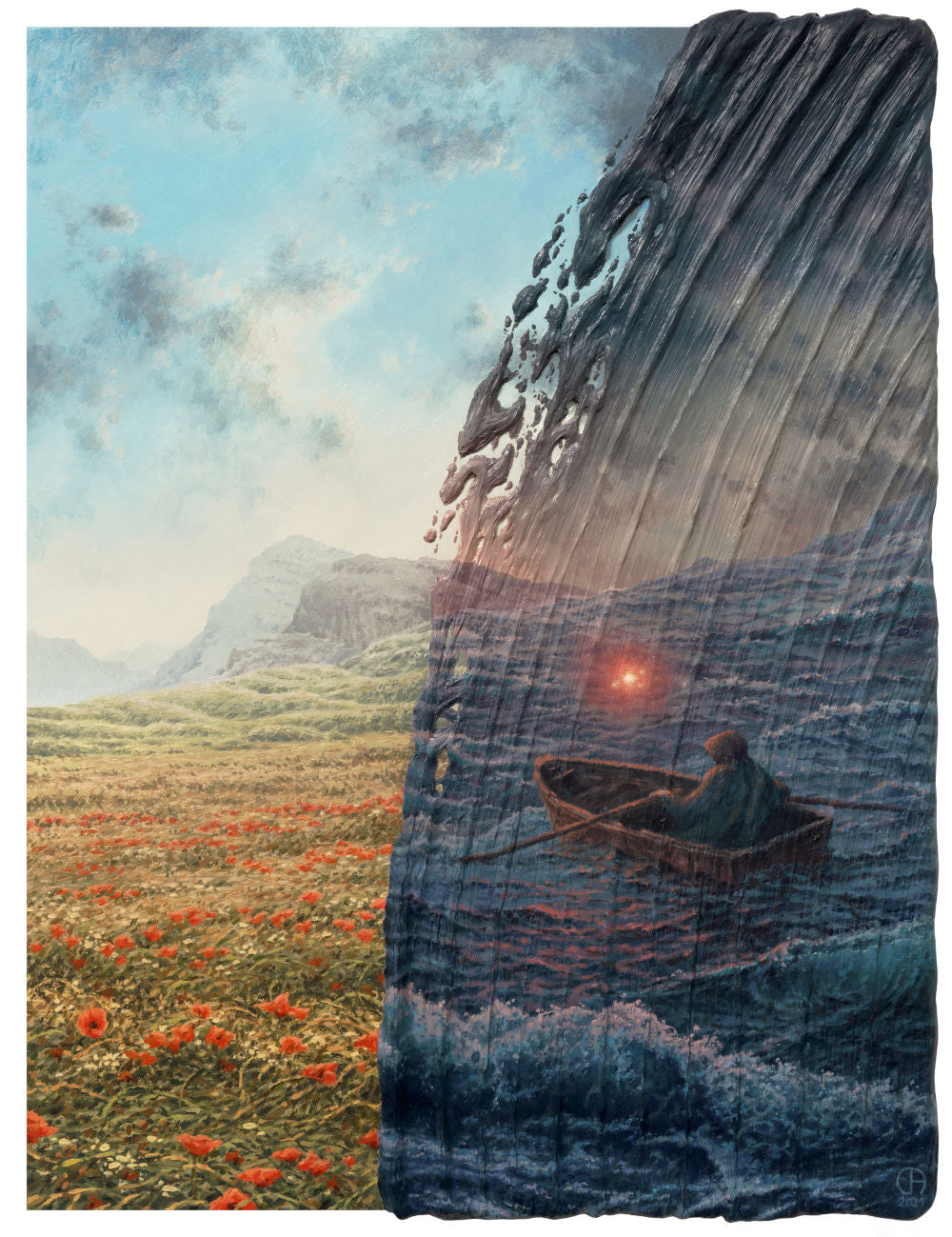
Gezeitenwelle - Oil on wood panel for David Ambarzumjan's solo show, Brushstrokes in Time, at Beinart Gallery.
IRS: Your ‘Brushstrokes in Time’ series has become very popular and recognisable, how did it come about? What do the brushstrokes mean to you?
DA: The series started out with smaller 20 x 20cm paintings of brushstrokes depicting natural landscapes, juxtaposed against the black and cold expanses of space. These are landscapes I’ve been to, but also landscapes I've imagined myself being in. I wanted to show how diverse life is and how incredible it is that all this originated from nothing but dust in outer space. A brushstroke of life on a blank canvas, so to say.
I asked myself how I could explore this theme more deeply, to show how the earth has changed over time. I’ve always been fascinated by time travel in books and TV, and felt like I could use the brushstroke as a vehicle to do just that, explore the same place at a different time. This was a perfect way for me to play around with colors and contrasts and imagine different scenarios in the future.
I think the brushstroke can have so many different meanings. Sometimes it’s a reminder of the past, sometimes a premonition of what’s to come. It can show the force and resilience of nature yet also how humanity had its hand in influencing it.

Untitled 20 x 20cm piece - by David Ambarzumjan for his Brushstrokes in Time series.
IRS: A lot of your current, larger works speak about the earth through the passage of time: what it was and what it is, and what it could be. Many of these pieces seem to speak of the impact humans have and will have on the earth. Was that environmentalism always at the heart of your work?
DA: There is no way you can speak about the earth’s changes over time without addressing the human impact we have had, and continue to have, on this planet. I think it’s fascinating but also concerning, to think that after the billions of years that the earth was around without humanity, we’ve managed to impact the planet in such a big way in just the short time we’ve inhabited it. It’s obvious when I contrast natural landscapes against city life, which I’ve done in a few paintings in the past, but I think there are much more nuanced ways to show how and where we might have influenced nature.
I like to think about it as a struggle for control. Sometimes life does things we have no control over, in a sense holding the paintbrush with a firm hand. Other times we completely take over or rather paint over what once was. But most of the time we slightly nudge the paintbrush into depicting a different outcome through our actions, causing problems that we will have to deal with in the future.
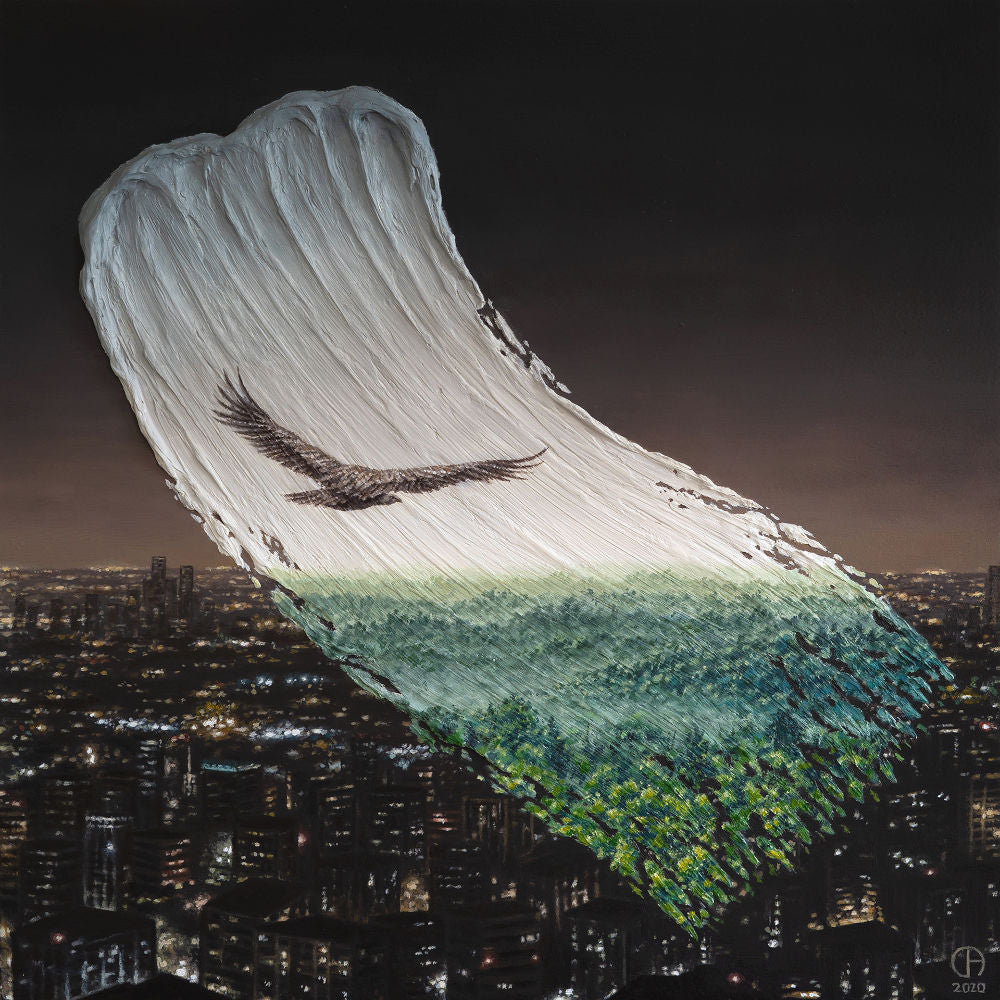
Breathe - by David Ambarzumjan for his Brushstrokes in Time series.
IRS: I’d like to discuss your process in making one of these Brushstroke works. I’ve seen that you paint the entire background painting with great detail before painting the disruptive brushstroke over it. Why is it that you choose to work this way? And do you pre-plan all the elements of this brushstroke and what it will contain, or is it more organic?
DA: A lot has changed since I’ve started this series and with it also the process of creating these works. The first few works I’ve done depict a brushstroke in the center of the painting. To create a consistent composition, I painted the whole background before deciding on where and how exactly I would be painting over it. I also wanted to record the process as a way to show the audience what this series is about. To give an example, with the painting “Recover” I created three years ago, I recorded myself painting over the cityscape with a giant white brushstroke. The initial video didn’t show the final painting at the end so what people were left to look at was a single white stroke of paint on top of a city scene painted with great detail. There was no instant gratification for the audience, even though that’s what we’ve gotten used to in the social media world. Many people in the comments didn’t shy away from expressing their anger towards me for what they saw. But the act of me seemingly "ruining" the painting and the reaction it caused was part of the work itself. Some people seem to forget that the process of painting isn’t always pretty. I had to look at that white stroke for days until it slowly developed into the finished painting with many doubts in between.
All in all it was the perfect way to showcase the messiness of the process, although I really enjoyed the "calculated destruction" itself. There are not many moments when working on a painting where I can feel my heart racing. But if I would do that with every new painting, I would definitely lose the excitement for that moment, and sharing a video of it would get repetitive after a while. Newer paintings in the series have the brushstroke cover about half of the painting down to the edges, so it’s easier to create a cohesive composition without fully rendering the background. The act of painting over it is left to the viewer to imagine themselves.
When it comes to planning the work, I have pretty much everything figured out before I start. Sometimes there are things that don’t work out, but then I also have new ideas that I didn’t think about before. So no matter how much I plan in advance, I still try to be open-minded to allow new ideas to grow.

Gravity - Oil on wood panel by David Ambarzumjan's solo show, Brushstrokes in Time, at Beinart Gallery.
IRS: As mentioned earlier, there has been some variety and evolution in your themes within this Brushstrokes in Time series, could you describe any unique themes and narratives you’ll be specifically exploring with the series for your upcoming show with us at Beinart Gallery?
DA: I’ve created five new paintings for the show. With these new works in the series, I wanted to turn my focus away from urban scenes and towards natural landscapes, while still highlighting our influence on them, whether in the past, present or future. As with previous works in the series, I wanted to emphasize how diverse and unpredictable life is and how we can find parallels in the wildest differences.
I was also excited to experiment more with whimsical elements and surreal compositions with bigger and bolder, more textural brush strokes, conveying a sense of movement in the work. To make these contrasting scenes co-exist in one single composition, I was trying to find similarities between them, bridges that would connect light and darkness, life and death, warmth and coldness, creating a space where extremes can meet and intersect without the control of time.
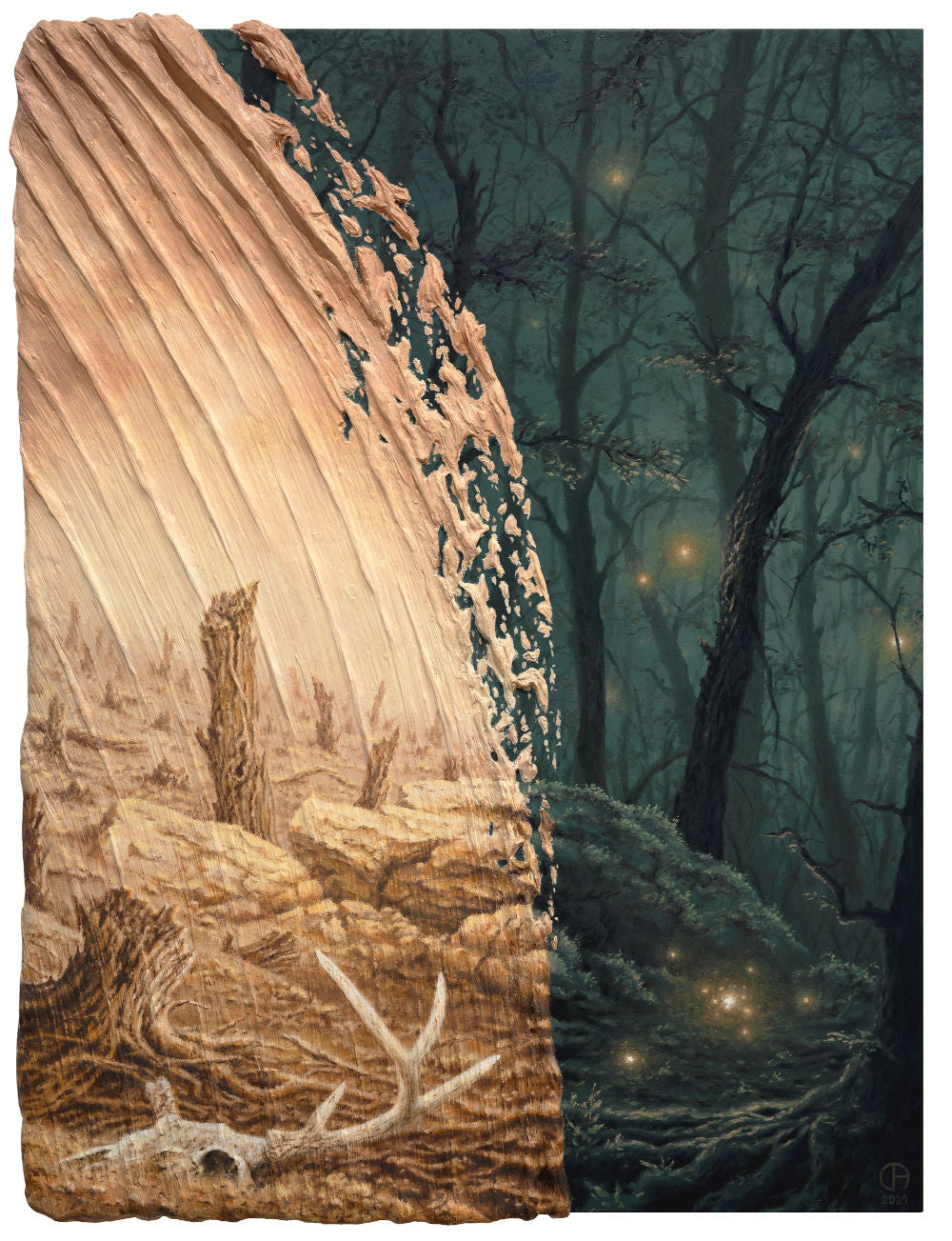
Deserted - Oil on wood panel for David Ambarzumjan's solo show, Brushstrokes in Time, at Beinart Gallery.
IRS: You have quite a large online and social media following, what’s that like for you as a young artist still very early in your career? Do you feel that it puts you under pressure or is it more of an encouragement?
DA: It’s definitely a bit of both. Having so many people follow and appreciate the work I do is still something I have to wrap my mind around from time to time. There is always a sense of vulnerability when sharing new work, not knowing how it might be perceived.
I’d be lying if I said I don’t care what people think about my work. I do, but at the end of the day, that’s not why I do it. I don’t want to let the opinions about my latest work, good or bad, influence what I will do next because I would not enjoy it or be able to grow artistically that way. Overall, I’m very grateful for the support I get, even though it can sometimes feel overwhelming.

Untitled 20 x 20cm piece - by David Ambarzumjan for his Brushstrokes in Time series.
IRS: You’ve used some of your Instagram auctions of small pieces to raise awareness and funds for a variety of charitable causes from bushfire relief for the Australian bushfires of 2019/2020 to the Black Lives Matter movement. Why did you decide on these causes and what gave you the idea?
DA: What moved me to dedicate an auction to these causes in particular were the horrifying photos and videos of what was happening going around the internet. I instantly felt like I had to do something, anything to help in the smallest way. Over the past few years, I’ve established a place on Instagram where people can participate in auctions to purchase one of the 20x20cm paintings I mentioned earlier. So I already had the platform I could use to occasionally raise awareness and money towards a dedicated cause. I’m excited to continue doing so once I get back to working on new miniature paintings.

Reverie - Oil on wood panel for David Ambarzumjan's solo show, Brushstrokes in Time, at Beinart Gallery.
IRS: What do you think is next for you and the Brushstrokes in Time series?
DA: I’m looking forward to traveling more since I haven’t been able to do that in a long time. This will hopefully inspire me to further experiment with the series to see where I can take it next. It’s daunting but also exciting, not knowing what’s to come. But seeing as the future hasn't been written yet, I feel like the possibilities are endless. We’ll just have to wait and see!
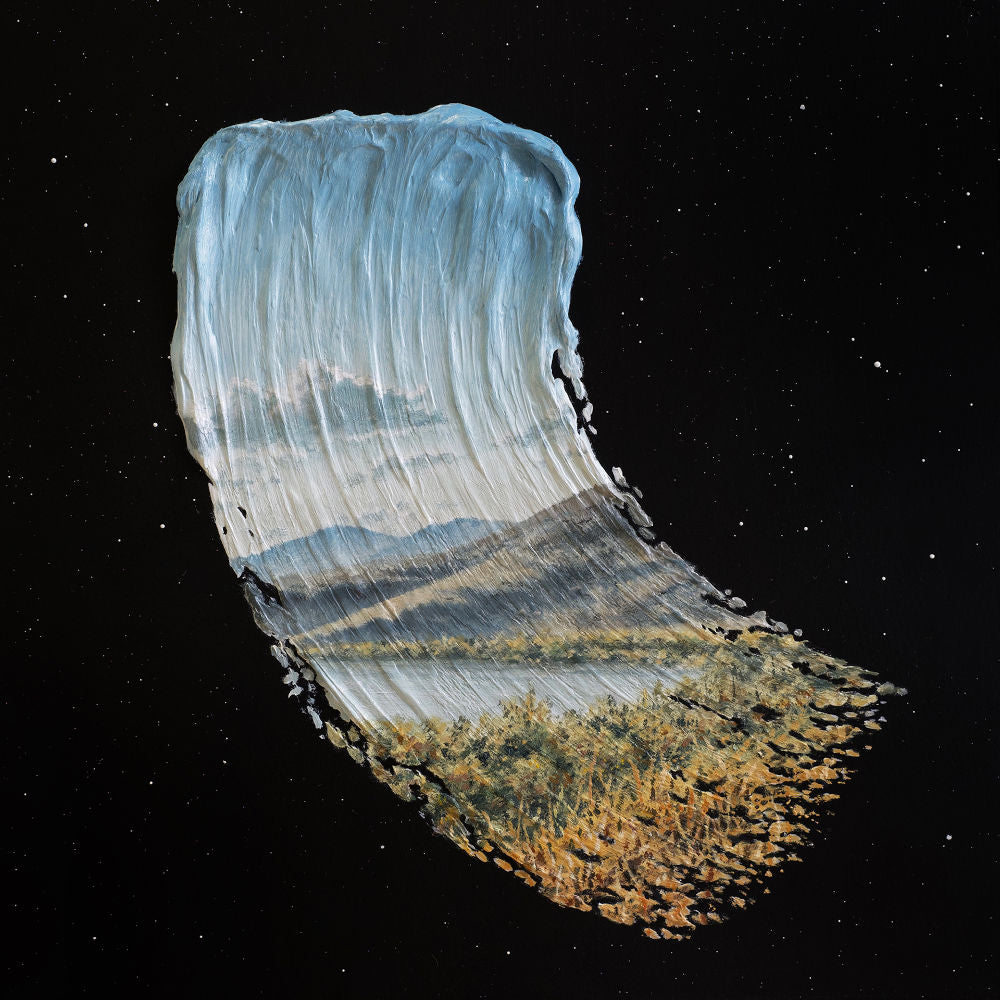
Untitled 20 x 20cm piece - by David Ambarzumjan for his Brushstrokes in Time series.
This interview was written by Indigo Rawson-Smith for Beinart Gallery in July 2021.
Indigo Rawson-Smith wears many hats, most notably as a Gallery Assistant at Beinart Gallery, Jeweller for her brand Indigo Nox Jewellery, and as a devoted snack enthusiast.
Having spent a few years working in galleries and art spaces around London she relocated to Melbourne to undertake full-time study in jewellery design, becoming a member of the Beinart Gallery crew in early 2021.
In a year when we’ve all felt the touch of isolation and find ourselves forgetting how to speak to people outside of our COVID safe “bubbles” Indigo has been attempting to polish up her rusty social skills while interviewing a number of Beinart Gallery’s exhibiting artists.




 Cart
Cart


